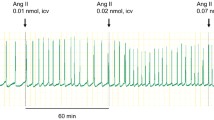Summary
Rats anaesthetised with Inactin, body temp. maintained at 37°C, were infused with mannitol-saline until both urine flow rate and conductivity reached a balanced state. In separate experiments under analogous conditions cardiac output was measured by dye dilution and organ flow rates by86Rb distribution. Doses of oxytocin of 3 ng or less, injected at or just below the carotid bifurcation, caused a highly significant natriuresis with increased tubular rejection, but no measureable haemodynamic changes. The same oxytocin dose given into the internal or external carotid artery above the bifurcation caused neither haemodynamic changes nor natriuresis. Injection of vasopressin, angiotensin and α-MSH at the sensitive site did not result in natriuresis in the same dosage range. Section of the sinus nerve significantly decreased the natriuretic response to oxytocin. It is suggested that the carotid body contains a specific oxytocin receptor capable of eliciting natriuresis in the rat.
Similar content being viewed by others
References
Adams, W. E.: The comparative morphology of the carotid body and carotid sinus, pp. 56–57 Springfield, Ill.: Ch. C. Thomas 1958
Akingugbe, O. O., Brown, W. C. B., Cranston, W. I.: The direct renal action of angiotensin in the rabbit. Clin. Sci.30, 259–266 (1966)
Albrecht, I., Vízek, M., Křeček, J.: The hemodynamics of the rat during ontogenesis with special reference to the age factor in the development of hypertension. In: K. Okamoto (ed.): Spontaneous hypertension — its pathogenesis and complications, pp. 121–127. Tokyo: Igaku Shoin, Ltd., 1972
Barraclough, M. A., Jones, N. F.: Effect of fluid retention following vasopressin on sodium excretion by hypertensive subjects. Clin. Sci.23, 433–440 (1962)
Bonjour, J. P., Regoli, D., Roch-Ramel, F., Peters, G.: Prerequisites for the natriuretic effect of val-5-angiotensin-2-amide in the rat. Amer. J. Physiol.214, 1133–1138 (1968)
Bonsnes, R. W., Taussky, H.: On the colorimetric determination of creatinine by the Jaffé reaction. J. biol. Chem.158, 581–591 (1945)
Brooks, F. P., Pickford, M.: The effect of posterior pituitary hormones on the excretion of electrolytes in the dog. J. Physiol. (Lond.)142, 468–493 (1958)
Brunner, H., Kuschinsky, G., Münchow, O., Peters, G.: Der Einfluß von natürlichem und synthetischem Oxytocin auf endogene Kreatinin-Clearance, Salzauscheidung und Sauerausscheidungsfähigkeit der Ratte und auf die Diurese des Menschen. Naunyn-Schmiedebergs Arch. exp. Path. Pharmak.230, 80–89 (1957)
Brunner, H., Kuschinsky, G., Peters, G.: Der Einfluß von Oxytocin auf die renale Wasser- und Salzausscheidung der Ratte. Naunyn-Schmiedebergs Arch. exp. Path. Pharmak.228, 457–473 (1956)
Cannon, P. J., Ames, R. P., Laragh, J. H.: Indirect action of angiotensin infusion to inhibit renal tubular sodium reabsorption in dogs. Amer. J. Physiol.211, 1021–1030 (1966)
Chan, W. Y., Sawyer, W. H.: Saluretic activity of neurohypophysial peptides in conscious dog. Amer. J. Physiol.210, 799–803 (1961)
Chan, W. Y., Sawyer, W. H.: Intracranial action of oxytocin on sodium excretion by the conscious dog. Proc. Soc. exp. Biol. (N.Y.)127, 267–269 (1968).
Cort, J. H., Lichardus, B. (ed.): Regulation of body fluid volumes by the kidney, pp. 1–10. Basel-München-Paris-New York: S. Karger 1970.
Cort, J. H., Rudinger, J., Lichardus, B., Hagemann, I.: Effect of oxytocin antagonists on the saluresis ascompanying carotid occlusion. Amer. J. Physiol.210, 162–168 (1966)
Heymans, C., Neil, E.: Reflexogenic areas of the cardiovascular system, pp. 23–25 London: J. A. Churchill, Ltd., 1958
Kramár, J., Grinell, E., Duff, W.: Observations on the diuretic activity of ADH. Amer. J. med. Sci.252, 53–61 (1966)
Langford, H. G., Pickering, G. W.: The action of synthetic angiotensin on renal function in the unanesthetized rabbit, J. Physiol. (Lond.)177, 161–173 (1965)
Louis, W. J., Doyle, A. E.: The effects of varying doses of angiotensin on renal function and blood pressure in man and dogs. Clin. Sci.29, 489–504 (1965)
Mertz, D. F.: Über die akute Wirkung von synthetischem Oxytocin auf die Nierenhämodynamik und renale Elektrolytausscheidung beim Menschen. Naunyn-Schmiedebergs Arch. exp. Path. Pharmak.239, 410–424 (1960)
Orías, R., McCann, S. M.: Natriuresis induced by alpha and beta melanocyte stimulating hormone (MSH) in rats. Endocrinology90, 700–706 (1972)
Peters, G., Roch-Ramel, F.: Renal effects of posterior pituitary peptides and their derivatives. In: H. Heller and B. T. Pickering (ed.): International encyclopedia of pharmacology and therapeutics, section 41, vol. 1. Oxford-New York: Pergamon Press 1970
Sedláková, E. Lichardus, B., Cort, J. H.: Plasma saluretic activity: its nature and relation to oxytocin analogs. Science164, 580–582 (1969)
Stelter, E.: Die Diurese der Maus nach oraler Gabe von Wasser oder NaCl-Lösungen und ihre Beeinflussung durch Hypophysenhinterlapppenhormone. Naunyn-Schmiedebergs Arch. exp. Path. Pharmak.237, 409–422 (1959)
Author information
Authors and Affiliations
Rights and permissions
About this article
Cite this article
Škopková, J., Albrecht, I. & Cort, J.H. A natriuresis receptor at the carotid bifurcation specifically activated by oxytocin. Pflugers Arch. 343, 123–132 (1973). https://doi.org/10.1007/BF00585707
Received:
Issue Date:
DOI: https://doi.org/10.1007/BF00585707




